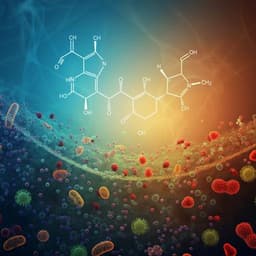
Biology
Membrane translocation process revealed by in situ structures of type II secretion system secretins
Z. Yu, Y. Wu, et al.
This research conducted by Zhili Yu, Yaoming Wu, Muyuan Chen, Tong Huo, Wei Zheng, Steven J. Ludtke, Xiaodong Shi, and Zhao Wang delves into the membrane translocation process of secretins GspDα and GspDβ in *Escherichia coli*. Through innovative electron cryotomography techniques, the distinct interaction patterns and models for these secretins provide new insights into T2SS biogenesis.
~3 min • Beginner • English
Introduction
Secretion systems are cell envelope-spanning protein complexes used by bacteria to secrete substrates that promote survival and pathogenicity. The type II secretion system (T2SS) is widespread in Proteobacteria, including non-pathogenic Escherichia coli and pathogens such as enterotoxigenic E. coli (ETEC), enteropathogenic E. coli (EPEC), Vibrio cholerae, Klebsiella pneumoniae, and Aeromonas hydrophila. T2SS substrates enable nutrient acquisition and symbiosis in non-pathogens and promote host adhesion, intoxication, and immune suppression in pathogens, linking T2SS to virulence and disease. Understanding T2SS structure and mechanism is therefore important for microbiology and antimicrobial strategy development.
The T2SS outer membrane component is the secretin (GspD), a large channel that connects to inner membrane scaffolding and controls the final step of substrate translocation. Phylogenetic analyses identify two secretin types: Klebsiella-type (e.g., Klebsiella, Dickeya) and Vibrio-type (e.g., Vibrio, ETEC, EPEC). Both are cylindrical channels comprising N0–N3 domains, a secretin domain with a central gate, and an S domain, but differ in the transmembrane region: Vibrio-type secretins possess an additional cap gate formed by an insertion between α7 and α8, whereas Klebsiella-type lack this cap gate. Prior in situ visualization of a T2SS in Legionella pneumophila provided architectural insights but limited resolution precluded detailed membrane interaction analysis. High-resolution in situ structures are needed to reveal assembly and membrane translocation mechanisms under native cellular conditions.
Translocation of secretins from the inner membrane (IM) to the outer membrane (OM) is essential for T2SS assembly, yet its regulation within the envelope is unclear. Biochemical studies suggest two pathways: (1) scaffolding proteins GspA and GspB enlarge peptidoglycan (PG) pores to allow secretin passage (noted for Klebsiella-type secretins), and (2) a pilotin (GspS) binds the secretin S domain and escorts it to the OM via the Lol pathway (Vibrio-type). Some T2SSs lack GspA/B or pilotin, implying additional pathways. Here, using cryo-electron tomography (cryo-ET) and subtomogram averaging, we visualize intermediate states of E. coli secretins GspDα (K12; Klebsiella-type) and GspDβ (ETEC H10407; Vibrio-type) during OM translocation, determining four in situ structures: GspDα on the IM, GspDα on the OM, GspDβ–GspS complex on the OM, and GspDβ on the IM. These structures delineate membrane interactions and inform secretin biogenesis models.
Literature Review
Prior work established two phylogenetic and structural secretin classes, Klebsiella-type and Vibrio-type, with a key difference in the transmembrane region: Vibrio-type secretins feature an extra cap gate formed by a loop between α7 and α8, absent in Klebsiella-type. In vitro structures show C15 symmetry and domain organization (N0–N3, secretin gate, S domain). An in situ cryo-ET study of the Legionella pneumophila T2SS suggested secretin interaction with only one leaflet of the OM but lacked resolution for detailed interpretation. Biochemical studies propose two translocation mechanisms: (i) GspA/GspB scaffolding proteins enlarge peptidoglycan pores to permit secretin passage (reported for ExeD/OutD), and (ii) pilotins (e.g., GspS) bind the secretin S domain and escort it via the Lol pathway to the OM (seen for Vibrio-type secretins). Moreover, T2SS operons vary, with some lacking these factors, hinting at alternative routes. E. coli encodes two T2SS operons: a Klebsiella-type secretin (GspDα) implicated in non-pathogenic functions such as chitinase secretion, and a Vibrio-type secretin (GspDβ) associated with toxin secretion in pathogens such as ETEC/EPEC. Despite biochemical insights, translocation intermediates had not been visualized in living cells, motivating high-resolution in situ structural studies.
Methodology
The study employed a minicell system to obtain thin, physiologically active E. coli cells suitable for cryo-ET. GspDα (E. coli K12) and GspDβ (ETEC H10407) were cloned and expressed in E. coli strains with or without co-expression of pilotin GspS; ΔgspS strains were also used. Where indicated, cells were grown with 40 mM D-methionine to reduce peptidoglycan crosslinking. Protein expression and membrane localization were evaluated by immunoblotting with anti-His antibodies, outer/inner membrane separation via sucrose density gradient centrifugation, and outer membrane protein extraction.
Samples were vitrified on carbon-coated grids using a Vitrobot and imaged by cryo-ET. Tilt series were collected from −50° to +50° at 5° steps with total dose ~100 e/Ų. GspDα datasets (IM and OM) were acquired on a 300 kV Titan Krios with a Gatan K2 Summit detector (pixel size 1.76 Å) using bidirectional acquisition; other datasets (GspDβ OM with/without GspS, and GspDβ IM in ΔgspS) were acquired on a 200 kV FEI Glacios with a Falcon 4 detector (pixel size 1.52 Å) using dose-symmetric acquisition.
Data processing was performed in EMAN2. Motion correction used MotionCorr2; tilt-series alignment, tomogram reconstruction, and CTF correction were in EMAN2. Subtomogram averaging involved manual particle picking, initial model generation, iterative refinements imposing C15 symmetry, and symmetry verification by C5 refinements. To resolve top/bottom view ambiguity due to cylindrical symmetry, a custom EMAN2 algorithm leveraged membrane geometry to correct particle orientations by 180° flips when necessary. Symmetry determination included testing alternative cyclic symmetries and measuring particle radii from 2D projections. To visualize asymmetric membrane contacts, symmetry was relaxed (C1) with focused classification on the membrane-contact region and rotational freedom about the symmetry axis for one iteration, followed by local refinements. Focused refinements on the protein (excluding membrane) were compared to integrated refinements to derive per-particle tilt differences, enabling reconstruction of a swing trajectory for GspDα on the IM. Final maps achieved resolutions between 9 Å and 19 Å (gold-standard FSC). In vitro structures (e.g., PDB: 5WQ7 for GspDα; PDB: 5ZDH for GspDβ–GspS) were fitted to interpret domain organization and membrane insertion.
Key Findings
- Four in situ structures captured distinct membrane-associated states of E. coli T2SS secretins: GspDα on the IM (9 Å), GspDα on the OM (16 Å), GspDβ–GspS on the OM with GspS coexpressed (19 Å), and GspDβ–GspS on the OM without GspS overexpression (16 Å); additionally, GspDβ multimer on the IM was resolved in ΔgspS (14 Å).
- GspDα on the IM: ~32,000 particles were averaged to 9 Å resolution, revealing a spool-shaped C15-symmetric channel bound to the IM with a sealed gate-facing membrane side and an open periplasmic side. The N0–N3 domains are resolved. The transmembrane region penetrates only one leaflet of the IM and does not open a pore. Symmetry-relaxed maps show a partial, asymmetric membrane contact spanning ~100° of the periphery, indicating a loose, flexible association. Orientation analysis reveals a swing around the membrane contact site with a tilt change of ~2.86° between endpoint conformations.
- GspDα on the OM: Growth with 40 mM D-methionine (reducing PG crosslinking) increased OM targeting. From 309 OM particles, a 16 Å C15 map shows an evenly distributed membrane contact around the periphery and a stable, consistent conformation; symmetry remains clearly C15.
- GspDβ on the OM with GspS coexpression: In cells coexpressing GspDβ and GspS, particles localize exclusively to the OM (verified biochemically). From 514 particles, a 19 Å C15 map shows extra 15-fold densities at the membrane-adjacent periphery attributable to GspS, consistent with the fitted GspDβ–GspS complex (PDB: 5ZDH). The transmembrane region spans both leaflets of the OM, with the cap gate contacting the outer leaflet.
- GspDβ on the OM without GspS overexpression: Endogenous GspS is sufficient for OM localization; among 910 particles, classification yielded 723 OM particles producing a 16 Å map with discernible GspS densities attached, implying GspS remains associated post-targeting.
- GspDβ on the IM in ΔgspS: In ΔgspS cells, 370 IM particles yielded a 14 Å C15 map of a stable GspDβ multimer on the IM, with no GspS density and transmembrane insertion through both IM leaflets.
- Symmetry analyses across datasets confirmed C15 symmetry in situ for both secretins. The membrane insertion patterns differ fundamentally: GspDα penetrates only one leaflet, whereas GspDβ spans both leaflets (including its cap gate). D-methionine-mediated PG pore enlargement facilitates GspDα translocation to the OM without disassembly. Pilotin-dependent targeting of GspDβ results in a persistent GspDβ–GspS multimer complex on the OM.
Discussion
The in situ structures elucidate secretin biogenesis pathways and membrane interactions under native conditions. For GspDα (Klebsiella-type), multimers self-assemble on the IM and exhibit an asymmetric, partial membrane contact with measurable swinging, indicating a transient, unstable intermediate poised for translocation. Under normal PG crosslinking, GspDα multimers cannot traverse the PG layer; D-methionine-induced PG pore enlargement permits direct multimer translocation to the OM without disassembly, where GspDα adopts a more stable, uniformly membrane-engaged conformation suited for secretion. The asymmetric IM contact likely lowers the energy barrier for release and transit through the periplasm.
For GspDβ (Vibrio-type), observations support a pilotin-mediated pathway: GspDβ forms IM multimers when GspS is absent (ΔgspS), but in the presence of GspS (endogenous or overexpressed), GspDβ localizes to the OM in complex with GspS, with pilotin densities remaining attached to the multimer. The data are consistent with a model where GspS binds GspDβ monomers in the periplasm after initial IM assembly and escorts them via the Lol pathway to the OM, where reassembly yields a stable GspDβ–GspS multimeric channel. The persistent association of GspS with the OM multimer suggests a structural/functional role beyond targeting.
A notable mechanistic distinction is the membrane insertion pattern: GspDα engages only one leaflet, while GspDβ spans both leaflets with its cap gate contacting the outer leaflet. This could influence channel stability and efficiency, potentially explaining evolutionary selection for Vibrio-type systems in actively expressed T2SS operons. The findings refine models of secretin translocation, reconcile prior biochemical evidence, and provide a structural framework for how PG remodeling (for GspDα) and pilotin-dependent targeting (for GspDβ) enable OM biogenesis.
Conclusion
This work presents four in situ cryo-ET structures capturing intermediate and final states of T2SS secretins during membrane translocation: GspDα on both IM and OM, and GspDβ on IM (ΔgspS) and as GspDβ–GspS complexes on the OM. The results reveal that GspDα forms a flexible, partially IM-bound multimeric intermediate that translocates as a multimer to the OM when PG pores are enlarged, becoming more stable at the OM. In contrast, GspDβ employs a pilotin-dependent route where GspS binds and escorts monomers to the OM, followed by multimer reassembly, with GspS remaining associated. Distinct membrane insertion patterns (single-leaflet for GspDα versus bilayer-spanning for GspDβ) likely underlie functional and evolutionary differences between secretin types. Future work should directly visualize GspDβ monomer shuttling with GspS in the periplasm, determine the in vivo conformation enabling single-leaflet insertion for GspDα, and delineate additional factors (e.g., GspA/GspB) that may facilitate translocation in vivo.
Limitations
- Many inner-membrane–associated observations derive from overexpression systems, which may not fully recapitulate native expression conditions.
- Cryo-ET does not directly visualize transient steps such as GspDβ multimer dissociation into monomers and pilotin-bound periplasmic transit; these steps are inferred from structural states and biochemistry.
- Despite D-methionine treatment, not all GspDα particles relocalize to the OM, indicating additional, uncharacterized pathways or factors may be involved (e.g., GspA/GspB).
- The observed single-leaflet membrane insertion of GspDα is biophysically unexpected and requires further investigation to define the precise in vivo conformation and interactions enabling this state.
- Resolution limits (9–19 Å) preclude side-chain-level assignments and detailed interaction mapping at the membrane interface.
Related Publications
Explore these studies to deepen your understanding of the subject.







